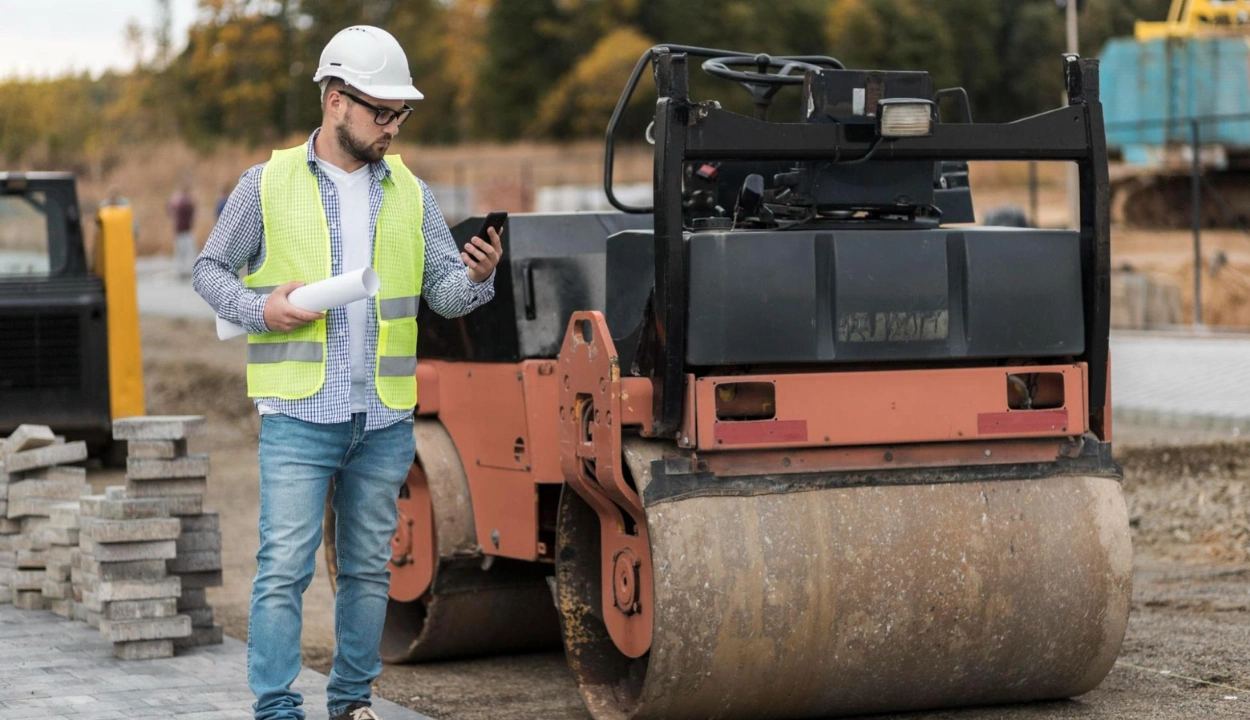Choosing the Right Equipment Management Software for Your Business
Whether you are a full-time contractor or just own a small construction business that owns and manages construction equipment and vehicles,
Keeping track of all your equipment manually can be an additional hassle for your employees.
You should consider investing in equipment management software to save time, money, and effort.
How do I choose management software? Consider checking our Tips for Equipment Management Software.
Understanding Construction Equipment Management Software

Construction equipment management software helps construction companies track and manage their heavy equipment.
The software offers top-of-the-line features like asset tracking, maintenance, and equipment optimization.
This software can also help you track the maintenance schedule and suggest when an item of equipment might need a checkup.
The main goal of construction equipment software is to help reduce equipment downtime and maintenance costs and ensure that the machinery is always in optimal condition.
It helps keep the project running smoothly and without any hindrances.
Importance of equipment management software
Managing construction equipment is a big challenge.
Construction companies rely on machines and vehicles like diggers, trucks, and cranes to do the job.
Making sure these machines work well is essential for a few reasons:
- Cost-effectiveness—Construction equipment costs a lot of money; if it breaks down, the company can lose money and experience downtime. So, having construction asset tracking software for your organization helps you keep track of your assets, saving you money.
- Time Management—When equipment breaks down, it causes project delays. Equipment management software allows contractors and project managers to keep track of the equipment and plan regular checkups to ensure the machinery doesn't break down.
- Rules and Regulations—Construction sites have specific rules to manage their security and quality. Equipment management software ensures that all laws and regulations regarding equipment are correctly followed.
- Asset Utilization - You want the most out of your equipment, so using them efficiently and managing maintenance is essential to ensure your asset remains working.
How to get started
Before starting any decision-making process, consider what you require from the system.
Before finding the project's best construction equipment tracking software, here are a few things to consider.
Assess your business needs.
Before selecting equipment management software for your construction project, this is essential.
Start by:
Evaluating Your Current Equipment Management Process:
- Review Current Practices: Look closely at how your business manages its equipment, including how it is tracked, maintained, and used daily.
- Gather Data: Collect equipment usage, maintenance records, downtime, and repair costs. It will help you get insights into the effectiveness of your current process.
- Identify Stakeholders: Involve key stakeholders, such as equipment operators, maintenance staff, and management, in the evaluation process.
- Their opinions are precious for your decision-making.
Identifying Pain Points and Areas for Improvement:
- Document Challenges: Identify specific areas where you might face challenges or pain points in your equipment management process. It will help you identify breakdowns, inefficiencies, or scheduling issues.
- Seek Feedback: Involve employees in gathering feedback on issues, identifying their frustrations, and ways to improve.
- Consider Future Needs: Consider your business's growth. Are any new projects coming up, and how will they change or impact your equipment management needs and requirements? Always anticipate changes.
Additional Considerations:
- Technology Assessment: Evaluate your current technology and see if your equipment management system can improve upon any gaps.
- Compliance and Regulations: Consider any regulatory requirements or industry standards directly impacting your business.
- Budget and Resources: Asses your budgets and resources and see if there is room for any new adjustments. Since equipment management software is an additional cost, you must have room for it in your budget.
Key considerations while choosing equipment management software
What should you look for when considering equipment management software?
The most important factor is scalability, which means how the software can grow with your business.
Moving to the next factor, can the software be customized to fit your needs, or does it not offer flexibility?
The next point you should focus on is choosing easy software for technologically advanced and inept personnel.
Scalability
Scalability is one of the most crucial points in selecting equipment management software.
As most construction businesses aim for growth, your choice of software has to be able to accommodate that growth.
Your equipment management software should be able to handle increased assets, users, and locations.
It should grow with your business, offering long-term flexibility and adaptability as it evolves.
Customization
Customization is valuable in equipment management software, allowing businesses to operate uniquely.
The software should be able to customize alerts, reports, and other functions to align with the workflows and preferences.
Data Security

Data security is essential when dealing with sensitive equipment and operations.
Always verify that your software employs robust security measures to ensure data safety.
Look for features like data encryption, access controls, and regular updates.
Protecting your data against unauthorized usage is crucial for maintaining the integrity of your equipment management system.
Integrations
Since your business already has a system implemented, you need your equipment management software to integrate well with that system.
Look for software that can easily be integrated into systems without hassle or hindrance.
Seamless integration with accounting, project management, and other relevant software streamlines operations, minimizing duplicate efforts and ensuring consistent data across systems.
Integrations also simplifies reporting and enhances overall efficiency.
Customer Support

Since you are working with a new system, customer support is crucial, as you will have questions.
Look for a system with quick and effective customer support so you can address your issues and easily get solutions.
Equipment management systems that provide a responsive and knowledgeable support team minimize any additional disruptions and ensure that you operate smoothly.
User-friendliness
In an industry like construction, you need software with an intuitive interface.
Since this field has both technologically apt and unapt personnel, you need an interface that is easy to operate but still offers all the features that might be needed at any construction point.
You need software with all the features you need but only requires a little time to understand and learn.
Types of equipment management software
Some types of equipment management software include asset tracking, maintenance, fleet management, and field service management.
These solutions help monitor assets, streamline maintenance, optimize fleets, and manage field operations efficiently.
Asset tracking ensures efficient asset utilization, CMMS minimizes downtime, fleet management optimizes vehicle usage, and field service management streamlines technician scheduling and job tracking.
Together, they enhance productivity and reduce costs across industries.
Asset tracking software

Asset tracking software is explicitly designed to help contractors and project managers manage and monitor their physical assets, including construction equipment, tools, and vehicles.
This software lets companies track their assets' location, status, and usage in real-time, providing a visible asset inventory.
Some key features of Asset management software include:
- Barcode for easy asset identification.
- Asset location tracking using GPS or indoor positioning systems.
- Maintenance schedule to ensure equipment is serviced on time.
- Reporting and analytics to analyze asset usage and performance.
- Integration with other systems, such as inventory management and accounting software.
Asset tracking software is helpful in construction to prevent the loss or theft of valuable equipment.
It also ensures optimum asset utilization and compliance with maintenance schedules and regulations.
Maintenance management software
Construction Equipment Management and Tracking software designed to streamline equipment maintenance operations.
It helps to prolong the lifespan of equipment.
This software helps businesses schedule and track maintenance tasks, manage work, and track parts inventory.
Some key features of Software and equipment maintenance include:
- Preventive maintenance scheduling based on time, usage, or condition.
- Work order management to prioritize and assign maintenance tasks.
- Asset history tracking to monitor repairs and maintenance activities.
- Inventory management to track spare parts and supplies.
- Mobile access for technicians to view and update maintenance tasks in the field.
CMMS is vital for construction companies and projects. It helps minimize equipment downtime and maintenance costs and ensures compliance with safety and regulatory requirements.
Fleet management software

Fleet management software is designed to manage fleets of vehicles and heavy equipment used in construction projects.
They help companies manage fleet operations, improve driver safety, and reduce fuel costs.
Some key features of fleet management software may include the following.
- Vehicle tracking and real-time location monitoring using GPS.
- Driver behavior monitoring to promote safe driving habits and reduce accidents.
- Fuel management to track fuel consumption and identify fuel-efficient routes.
- Maintenance schedule to ensure vehicles are serviced regularly.
- Compliance management to track driver hours, vehicle inspections, and regulatory requirements.
By implementing fleet management software, construction companies can improve fleet efficiency and reduce operating costs.
Field service management software
Field service management software is designed to manage and optimize field service operations.
It can include equipment maintenance and repairs.
This software helps businesses schedule and dispatch technicians, track job progress, and communicate with clients.
Some key features of field service management software include:
- Job scheduling and dispatching to assign tasks to technicians efficiently.
- Mobile access allows technicians to access job details and update work orders in real-time.
- Customer communication tools such as automated notifications and appointment reminders.
- Work order management to track job progress and document completed tasks.
- Reporting and analytics to monitor field service performance and identify areas for improvement.
Construction companies must employ field service management software to streamline operations, improve client satisfaction, and maximize workers' productivity.
How to choose the right equipment management software
Here are a few simple tips for equipment management software that you can quickly check off to find the best fit for your project.
- Assess Your Needs: Before starting, examine your project and identify the areas that need improvement. Based on that, start to thoroughly understand what is required.
- Prioritize Features: Make a list of features that you need from the software. Prioritize important features like asset management, equipment management, etc.
- Consider Scalability: When selecting an equipment management software, choose one that can grow with your business.
- Evaluate Customization Options: Look for software that fits your needs and offers customization options so you can tailor solutions that best suit your requirements.
- Check Integration Capabilities: Look for software that can be easily integrated with your existing workflow systems and doesn't require much additional cost for its integrations.
- Assess User-Friendliness: Choose equipment management software with an intuitive interface that is easy for your team to understand and learn. Consider checking out demos and user trials to test the software's adoption.
- Review Maintenance and Support: When choosing the best fit, prioritize software that offers ongoing support and maintenance. Ensure you get timely assistance from the team to address any issues quickly.
- Ensure Data Security: Choose software prioritizing data security and compliance with industry regulations. Look for features such as encryption, user access controls, and regular security audits to protect sensitive information.
- Seek User Feedback: Before investing in software, consider checking out the reviews and feedback from current users to see if there are any issues.
- Request Demos and Trials: Request a demo or a trial version before purchasing the official software. This will allow you to examine the product's features and suitability before committing.
- Seek References: Similar to feedback, ask your vendor if you can speak to any of their current users to assess how the software performs and how it can suit your business needs.
Final Thoughts
Choosing the right equipment management software is vital for the success of any construction business.
Whether you are a full-time contractor or own a small construction company, investing in equipment management software offers a comprehensive solution.
You can make the right choice for your business by considering certain factors, including scalability, customization, integration capabilities, user-friendliness, and data security.
You can choose the right equipment management software for your business.
If you are looking for an all-in-one solution, we recommend checking out Clue for its comprehensive solutions.
The platform offers everything you need, from asset tracking to fleet management, maintenance management, and even field service management.
It is the perfect fit for any construction project.
FAQs
What is equipment management software, and why do I need it?
Equipment management software helps construction companies monitor their machines and vehicles, plan maintenance, and reduce downtime. It automates equipment tracking, ensures timely repairs, and helps manage costs efficiently, making operations smoother and more cost-effective.
What are the key features I should look for in equipment management software?
The key features you should look for when considering equipment management software are scalability—how it can grow with your business—customization—whether the software allows for tailored solutions—integrations—whether it can integrate with your existing system—and most importantly, its cost. Will the price fit your budget?
How can I ensure the chosen software integrates well with my existing systems and workflows?
Before implementing any equipment management system in your company, ask about demos or a trial version of the software to help determine whether it fits your existing system or needs to be altered. If the system fits your needs, you should purchase and implement it in your business.
What level of training and support is provided with the equipment management software?
It's essential to understand the level of training and support the software provider offers. Inquire about training resources like user manuals, tutorials, and online training sessions. Additionally, ensure that the provider offers responsive customer support to address any issues or questions arising during implementation and ongoing use.
How can equipment management software benefit my business?
Equipment management software can benefit a business in several ways, including improving asset management and utilization, reducing maintenance costs, reducing downtime, and streamlining operations. The software can also provide real-time insights to help you make informed decisions.
Transform Your Equipment Management












